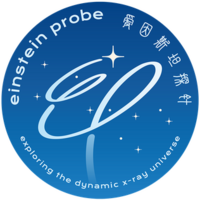Einstein Probe
| File:Einstein Probe spacecraft.jpg Einstein Probe artist impression | |
| Names | Aiyinsitan Tanzhen |
|---|---|
| Mission type | Space observatory |
| Operator | CAS, ESA |
| COSPAR ID | 2024-007A |
| SATCAT no. | 58753 |
| Website | ep |
| Mission duration | 3 years (planned) 4 months and 8 days (ongoing) |
| Spacecraft properties | |
| Spacecraft | Einstein Probe |
| Bus | Phoenix-Eye-2 |
| Manufacturer | CAS |
| Launch mass | 1,450 kg (3,200 lb)[1] |
| Dimensions | 3 × 3.4 m (9.8 × 11.2 ft) |
| Start of mission | |
| Launch date | 9 January 2024, 07:02 UTC[2] |
| Rocket | Long March 2C[2] |
| Launch site | Xichang LC-3 |
| Contractor | CASC |
| Orbital parameters | |
| Reference system | Geocentric orbit |
| Regime | Low Earth orbit |
| Perigee altitude | 581 km |
| Apogee altitude | 596 km |
| Inclination | 29° |
| Period | 96 minutes |
| Instruments | |
| Wide-field X-ray Telescope (WXT) Follow-up X-ray Telescope (FXT) | |
 Einstein Probe Logo | |
The Einstein Probe (EP) is an X-ray space telescope mission by Chinese Academy of Sciences (CAS) in partnership with European Space Agency (ESA) and the Max Planck Institute for Extraterrestrial Physics (MPE) dedicated to time-domain high-energy astrophysics.[3][4] The primary goals are "to discover high-energy transients and monitor variable objects".[5] It will carry two instruments: the Wide-field X-ray Telescope (WXT) and the Follow-up X-ray Telescope (FXT).[6]
FXT has optics adopted from eROSITA, "the mirror module consists of 54 nested Wolter mirrors with a focal length of 1600 mm and an effective area of greater than 300 cm2 at 1.5 keV."[6] WXT has a new optics design, called "lobster-eye", that has wider field of view.[4][6] "Lobster-eye" optics was first tested by the Lobster Eye Imager for Astronomy (LEIA) mission, launched in 2022.[4][7][8]
The probe weights 1450 kg and is 3-by-3.4 metres.[4]
Launch
Einstein Probe was launched on 9 January 2024, at 07:03 UTC by a Long March 2C rocket from the Xichang Satellite Launch Centre in China, and successfully placed in low Earth orbit at an altitude of 600 km.[2]
References
- ^ "Einstein Probe factsheet". ESA. Retrieved 10 January 2024.
- ^ a b c "Einstein Probe lifts off on a mission to monitor the X-ray sky". www.esa.int.
- ^ "Einstein Probe in a nutshell". www.esa.int. Retrieved 28 December 2023.
- ^ a b c d "Einstein Probe factsheet". www.esa.int. Retrieved 28 December 2023.
- ^ "Einstein Probe Time Domain Astronomical Information Center". ep.bao.ac.cn. Retrieved 28 December 2023.
- ^ a b c "EinsteinProbe". www.mpe.mpg.de. Retrieved 28 December 2023.
- ^ "Einstein Probe Time Domain Astronomical Information Center". ep.bao.ac.cn. Retrieved 28 December 2023.
- ^ Jones, Andrew (November 25, 2022). "China tests novel 'lobster eye' X-ray telescope for observing cosmic events". Space.com.
Further reading
- Yuan, Weimin; Zhang, Chen; Chen, Yong; Ling, Zhixing (2022). "The Einstein Probe Mission". pp. 1–30. arXiv:2209.09763.
